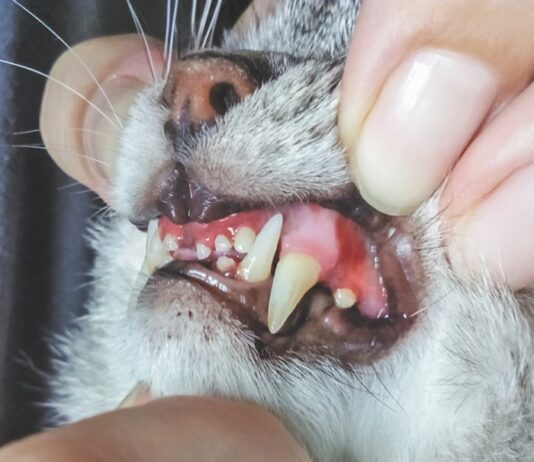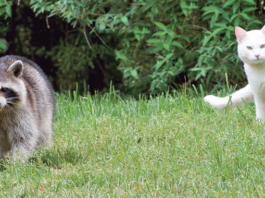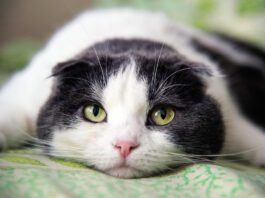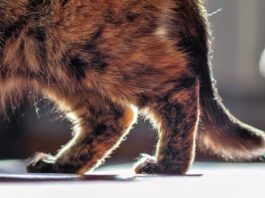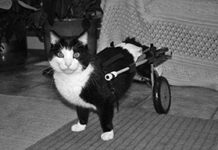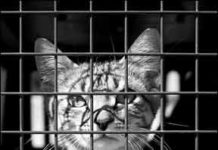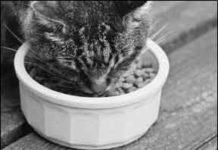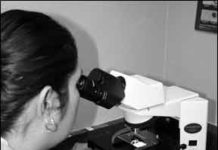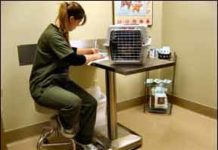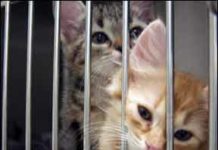How did the tabby and cheetah get their stripes?
Researchers gathered DNA and tissue samples from feral cats in Northern California. They also studied skin biopsies and blood samples from captive and wild South African and Namibian cheetahs, and in a study believed to the first to identify a molecular basis of coat pattering in mammals, they made this discovery: Tabby cats and rare king cheetahs share a gene responsible for the cats’ stripes and the cheetahs’ spots. However, when a mutation occurs, the tabby will develop patches of color rather than stripes, and the cheetah’s spots and blotches turn into wide stripes down its back.
Short Takes: January 2013
A Husky found the kitten lying in the street and gently carried him in his mouth home to his owner. Scooter had a broken spine and his back legs were paralyzed. Euthanasia would have been the likely fate for a kitten in similar shape. But Betsy Kennon, VMD, at Harts Run Veterinary Hospital in Fox Chapel, Pa., was determined to save his life — and she did. Hospital clients chipped in to buy Scooter a custom-made wheeled cart to get around.
Short Takes: December 2012
The American Humane Association has set an ambitious agenda. To reduce the number of healthy cats and dogs euthanized annually in the U.S., estimated at 3 million to 4 million, the association’s Animal Welfare Institute has launched a three-part study to better understand pet ownership and retention.
Short-Takes: November 2012
Ocean-going farewells A sea burial service, begun in Marshfield, Mass., with one boat, now has 48 vessels operating from Maine to Miami and from San Francisco to San Diego. Since he expanded the company in 2007 to include cremated pets, founder Capt. Brad White says his New England Burials at Sea has provided memorials for hundreds of animals. The company, one of a handful in the United States offering the service on both coasts, is…
Short Takes: October 2012
Two specialists in veterinary emergency and critical care have teamed up to help produce the first evidence-based guidelines for cardiopulmonary resuscitation in cats and dogs. When a preliminary survey showed little consistency in the rate of chest compressions administered by veterinarians during CPR, Daniel J. Fletcher, DVM, Ph.D., at Cornell and Manuel Boller, DVM, MTR, at Penn initiated a plan to develop evidence-based guidelines for CPR for veterinary patients. Although more than 20 percent of human patients who suffer cardiac arrest in the hospital survive to go home, perhaps partially as a result of the variability in compression rate, only 6 percent of dogs and cats do, according to recent veterinary CPR research.
Short Takes: September 2012
Biologists at the Royal Veterinary College in London may have discovered the reason for the cheetah’s record as the fastest living land mammal. Researchers at the college’s Structure and Motion Laboratory compared the cheetah’s gait to that of racing Greyhounds, whose speed tops out at 37 miles per hour. The big cats have been clocked at 64 miles per hour. “Cheetahs and Greyhounds are known to use a rotary gallop [in which the limbs fall in circular sequence around the body] and physically they are remarkably similar, yet there is this bewitching difference in maximum speed,” says researcher Alan Wilson, Bsc., Ph.d.
Short Takes: July 2012
Lymphoma is the most common cancer diagnosed in cats, and while several prognostic factors have been documented, another factor recently considered to be important is weight loss. Body weight over time may be a simple, objective and useful marker of patient status.
Short Takes: June 2012
Owners often bring their cats to the veterinarian due to a bout of constipation, which can have a variety of causes. Veterinary treatment includes determining and eliminating the cause, if possible, along with medical and sometimes surgical management. Medical therapy often includes the use of laxatives, enemas and prokinetic agents (like cisapride). Psyllium is a soluble fiber that produces a mucilaginous gel that helps to increase fecal bulk. It also adds to stool bulk by other water-holding properties. Psyllium has been found to increase stool frequency and consistency in humans with idiopathic constipation.
Short Takes: May 2012
Diagnostic decision-making can sometimes present a challenge to veterinary clinicians when they are presented with an apparently healthy adult cat with a heart murmur. Murmurs can be associated with cardiac disease — though some studies have also identified benign causes of murmurs in cats. Auscultation alone will not differentiate the cause of the murmur and additional diagnostics will be required. Feline murmurs can be inducible (upon physical provocation such as stress, fear or pain) or non-inducible (continuously present). A high percentage of cats with inducible murmurs appear to have no evidence of structural heart disease.
Short Takes: April 2012
In this recent study (“Prevalence of fecal-borne parasites detected by centrifugal flotation in feline samples from two shelters in upstate New York,” in Journal of Feline Medicine and Surgery, 2011), fecal samples from 1,322 cats from two shelters and foster homes in upstate New York were processed for parasite detection over three-and-a-half years. All samples were processed by zinc sulfate and sugar double centrifugal flotation.
Short Takes: March 2012
Boxiecat is a new online subscription cat litter service that can help save trips to the grocery store, and puts an end to lugging heavy bags of litter. Considering that there are 86.4 million pet cats living in the United States, this service can certainly fill the necessity for litter in a new and more convenient way — especially for the elderly or the handicapped pet owner.
Short Takes: February 2012
In shelter and rescue situations, it is extremely important for personnel to identify the most adoptable animals whose adoptions are unlikely to be delayed for medical reasons. This study (“Risk factors for delays between intake and veterinary approval for adoption on medical grounds in shelter puppies and kittens,” in Preventive Veterinary Medicine, 2011) was designed to identify risk factors for health-related delays from intake to approval for adoption in shelter puppies and kittens.

